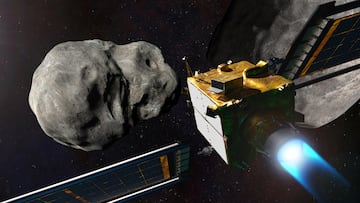Why did NASA crash into an asteroid and what happened during the collision?
The space agency successfully hit Dimorphos in the first test of a new planetary defence system designed to prevent a planet-ending collision.


On Monday NASA made its first attempt to disrupt the trajectory of an asteroid, testing its ability to divert a potential Armageddon-style impact in future. The near-Earth asteroid, named Didymos, did not pose any threat to the planet but the agency wanted to trial a new planetary defence system.
The Double Asteroid Redirection Test (DART) successfully made impact with Dimorphos, a moon orbiting the asteroid, as per the plan.
This is the first time that humanity has moved a planetary body in the universe, a key milestone for the space agency. History was made on Monday evening with a successful first attempt at the mission, which is thought to have cost around $324.5 million.
Images broadcast live from the space agency showed the exact moment the craft made contact with the asteroid, with the craft’s on-board camera getting ever-closer to the surface before the communication ended on impact.
IMPACT SUCCESS! Watch from #DARTMIssion’s DRACO Camera, as the vending machine-sized spacecraft successfully collides with asteroid Dimorphos, which is the size of a football stadium and poses no threat to Earth. pic.twitter.com/7bXipPkjWD
— NASA (@NASA) September 26, 2022
Dr Nancy Chabot, DART coordination lead, said: “It is such a team accomplishment to get to this moment after all these years. It’s happened now, we have done it.”
“Internationally people wanted to do this, wanted to take this first step and finally we did… I’m really honoured to be on this team and I know that others involved feel the same way.”
What did NASA do?
The prospect of a major asteroid hitting the earth and causing a mass extinction, as is thought to have happened some 66 million years ago, is a genuine doomsday scenario. The odds are incredibly remote, but NASA has been pushing to find solutions if the unthinkable were to occur.
Researchers targeted the Didymos and its moon, Dimorphos, to test out the latest technology. At 7:14pm EST (12:14am BST) the agency crashed a car-sized spacecraft into the mood, which was around 6.8m miles away from earth at the time.
We have impact! Around 7:14 p.m. EDT, the DART spacecraft crashed into the asteroid Dimorphos. What a watershed moment for planetary defense and all of humanity!
— Bill Nelson (@SenBillNelson) September 26, 2022
Here’s my message to the @NASA’s #DARTmission team. pic.twitter.com/9rNE4dxXjS
DART’s 15,000mph crash into Dimorphos was intended to generate enough impact to nudge the asteroid’s moon, and hopefully the asteroid itself, from its initial trajectory. At this early stage the process is still fairly rudimentary, but researchers were predominantly testing whether it could accurately hit the targeted body.
Related stories
This was why the team behind the DART launch opted for the Didymos system, which was close enough to earth for them to observe the impact and draw conclusions from the trial run.
A press conference is scheduled for 45 minutes after impact, during which mission managers will discuss the initial findings. However it will likely be weeks and even months before researchers get a full picture of how their efforts altered the trajectory of the asteroid and the future of humanity.

